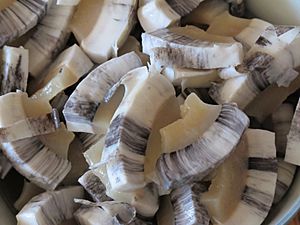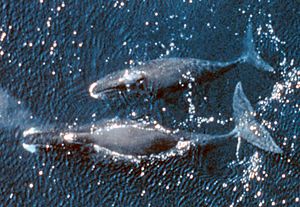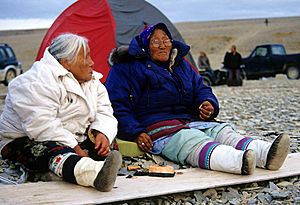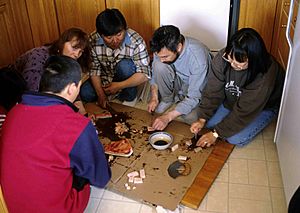Muktuk facts for kids
Muktuk is a special traditional food eaten by the Inuit people and the Chukchi people who live in the Arctic regions. It's made from the frozen skin and blubber (fat) of whales.
Muktuk is usually made from the skin and blubber of the bowhead whale. Sometimes, it's also made from the beluga whale or the narwhal. These whales are very important to the people who hunt them for food.
Contents
How is Muktuk Eaten?
Most of the time, muktuk is eaten raw. People also eat it frozen or cooked. Sometimes, it is finely chopped, coated in breading, and then deep-fried. This fried version is often served with soy sauce. Muktuk can also be pickled.
When you chew raw muktuk, the blubber becomes oily and has a nutty taste. The skin can be quite rubbery if it's not cut into small pieces or serrated.
Where Does Muktuk Come From?
In Greenland, muktuk (which they call mattak) is sold to factories that process fish. In Canada, it is sold to other communities. This helps share this important food.
Is Muktuk Healthy?
Muktuk is a good source of important vitamins. The skin part, called the epidermis, has a lot of vitamin C. For example, 100 grams (about 3.5 ounces) can have up to 38 milligrams of vitamin C. British explorers in the Arctic used muktuk to prevent scurvy, a sickness caused by not enough vitamin C. The blubber (fat) part of muktuk also has vitamin D.
However, as whales get older, some chemicals can build up in their bodies. Things like mercury can gather in the liver, kidneys, muscles, and blubber. Cadmium can also settle in the blubber. Muktuk can also contain PCBs and other chemicals. These can be harmful if too much is eaten.
Different Names for Muktuk
Muktuk has many different names depending on the language and where people live:
- Ikiilgin, in the Chukchi language.
- Maktaaq (ᒪᒃᑖᖅ), used in Siglitun, Kivalliq, Aivilik, North Baffin, East Baffin, and South Baffin.
- Maktak (ᒪᒃᑕᒃ), used by the Inupiat people, and also in Siglitun and North Baffin.
- Maktaq, used in Inuinnaqtun and Natsilingmiutut (Inuvialuktun).
- Mattak, used in Labrador and Greenland.
- Mangtak, used by Alaskan Yup'ik people.
- Mungtuk, used by Siberian Yupik people.
- Kimaq, used in Alutiiq/Sugpiaq.
In some dialects, like Inuinnaqtun, the word muktuk only means the edible parts of the whale's skin, not the blubber.
See also
 In Spanish: Muktuk para niños
In Spanish: Muktuk para niños





